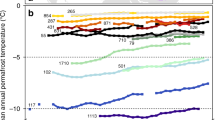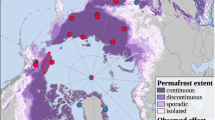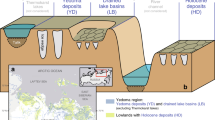Abstract
The magnitude and even direction of recent Antarctic climate change is still debated because the paucity of long and complete instrumental data records. While along Antarctic Peninsula a strong warming coupled with large retreat of glaciers occurred, in continental Antarctica a cooling was recently detected. Here, the first existing permafrost data set longer than 10 years recorded in continental Antarctica is presented. Since 1997 summer ground surface temperature showed a strong warming trend (0.31°C per year) although the air temperature was almost stable. The summer ground surface temperature increase seemed to be influenced mainly by the increase of the total summer radiation as confirmed also by the increase of the summer thawing degree days. In the same period the active layer exhibited a thickening trend (1 cm per year) comparable with the thickening rates observed in several Arctic locations where air warming occurred. At all the investigated depths permafrost exhibited an increase of mean annual temperature of approximately 0.1°C per year. The dichotomy between active layer thickness and air temperature trends can produce large unexepected and unmodelled impacts on ecosystems and CO2 balance.










Similar content being viewed by others
References
Åkerman HJA, Johansson M (2008) Thawing permafrost and thicker active layers in sub-arctic Sweden. Permafrost and Periglacial Processeses 19:279–292
Adlam LS, Balks MR, Seybold CA, Campbell DI (2010) Temporal and spatial variation in active layer depth in the McMurdo Sound Region, Antarctica. Antarct Sci 22(1):45–52
Benner R (2004) Export of young terrigenous dissolved organic carbon from rivers to the Arctic Ocean. Geophys Res Lett 31:5305
Burn CR, Zhang Y (2009) Permafrost and climate change at Herschel Island (Qikiqtaruq), Yukon Territory, Canada. J Geophys Res-Earth Surf 114:F02001
Cannone N, Guglielmin M (2009) Influence of vegetation on the ground thermal regime in continental Antarctica. Geoderma 15(3–4):215–223
Cannone N, Sgorbati S, Guglielmin M (2007) Unexpected impacts of climate change on Alpine vegetation. Front Ecol Environ 5:360–364
Cannone N, Wagner D, Hubberten H-W, Guglielmin M (2008) Biotic and abiotic factors influencing soil properties across a latitudinal gradient in Victoria Land, Antarctica. Geoderma 144(1–2):50–65.
Carlsaw HS, Jaeger JC (1959) Conduction of heat in solids. Oxford University Press, New York, p 510
Chapman WL, Walsh JE (2007) A synthesis of Antarctic temperatures. J Clim 20:4096–4117
Doran PT, Priscu JC, Lyons WB, Walsh JE, Fountain AG, McKnight DM, Moorhead DL, Virginia RA, Wall DH, Clow GD, Fritsen CH, McKay CP, Parsons AN (2002) Antarctic climate cooling and terrestrial ecosystem response. Nature 415:517–520
Fedorov AN, Konstantinov PY (2008) Recent changes in ground temperature and the effect on permafrost landscapes in Central Yakutia. In: Kane DL, Hinkel KM (eds). Proceedings of the Ninth International Conference on Permafrost, Fairbanks, Alaska, June 29–July 3,1, 433–438.
Fischlin A, Midgley GF, Price JT, Leemans R, Gopal B, Turley C, Rounsevell MDA, Dube OP, Tarazona J, Velichko AA (2007) Ecosystems, their properties, goods, and services. In: Parry ML, Canziani OF, Palutikof JP, van der Linden PJ, Hanson CE (eds) Climate Change 2007: Impacts, Adaptation and Vulnerability. Contribution of Working Group II to the Fourth Assessment Report of the ntergovernmental Panel on Climate Change. Cambridge University Press, Cambridge, pp 211–272
Frey KE, McClelland JW (2009) Impacts of permafrost degradation on arctic river biogeochemistry. Hydrolog Process 23(1):169–182
French H, Guglielmin M (1999) Observations on the ice-marginal, periglacial geomorphology of Terra Nova Bay, Northern Victoria Land, Antarctica. Permafrost and Periglacial Processes 10:331–347
French H, Guglielmin M (2000) Frozen ground phenomena in the vicinity of Terra Nova Bay, Northern Victoria land, Antarctica: a preliminary report. Geogr Ann Phys Geogr 82:513–526
Frezzotti M, Salvatore MC, Vittuari L, Grigioni P, De Silvestri L (2001) Satellite image map: northern foothills and inexpressible island area (Victoria Land, Antarctica). Terra Antarctica Reports 6: 1–8, plus map.
Gold LW, Lachenbruch AH (1973) Thermal conditions in permafrost: a review of North American literature. In: 2nd International Permafrost Conference, 13–28 July 1973, Yakutsk, U.S.S.R. National Academy of Sciencies, Washington, DC, pp. 3–25. North American contribution.
Goodrich LE (1982) The influence of snow cover on the ground thermal regime. Can Geotech J 19:421–432
Guglielmin M (2004) Observations on permafrost ground thermal regimes from Antarctica and the Italian Alps, and their relevance to global climate change. Global Planet Change 40:159–167
Guglielmin M (2006) Ground surface temperature (GST), active layer, and permafrost monitoring in continental Antarctica. Permafrost and Periglacial Processes 17(2):133–143
Guglielmin M, Dramis F (1999) Permafrost as a climatic indicator in northern Victoria Land, Antarctica. Ann Glaciol 29:131–135
Guglielmin M, Biasini A, Smiraglia C (1997) Buried ice landforms in the Northern Foothills (Northern Victoria Land, Antarctica). Some results from electrical soundings. Geogr Ann 79a(1–2):17–24
Hinkel KM, Paetzold RF, Nelson FE, Bockheim JG (2001) Patterns of soil temperature and moisture in the active layer and upper permafrost at Barrow, Alaska: 1993–1999. Global Planet Change 29:293–309
Hunt BG, Elliott TI (2006) Climatic trends. Clim Dynam 26:567–585
Ikard SI, Gooseff MN, Barrett JE, Takacs-Vesbach C (2009) Thermal characterisation of active layer across a soil moisture gradient in the McMurdo Dry Valleys, Antarctica. Permafrost and Periglacial Processes 20:27–39
Isaksen K, Sollid JL, Holmlund P, Harris C (2007) Recent warming of mountain permafrost in Svalbard and Scandinavia. J Geophys Res 112. doi:10.1029/2006JF000522
Jouzel J et al (2007) Orbital and millennial Antarctic climate variability over the past 800000 years. Science 317:793–796
Kane DL, Hinkel KM, Goering DJ, Hinzman LD, Outcalt SI (2001) Non-conductive heat transfer associated with frozen soils. Global Planet Change 29:275–292
Malkova GV (2008) The last twenty-five years of changes in permafrost temperature in the European Russian Arctic. In: Kane DL, Hinkel KM (eds), Proceedings of the Ninth International Conference on Permafrost, 253 Fairbanks, Alaska, June 29–July, University of Alaska Press, 3,1,: 1119–1124.
Mastepanov M, Sigsgaard C, Dlugokencky EJ, Houweling S, Ström L, Tamstorf MP, Christensen TR (2008) Large tundra methane burst during onset of freezing. Nature 456(4):628–631
Monaghan AJ, Bromwich DH, Fogt RL, Wang S, Mayewski PA, Dixon DA, Ekaykin A, Frezzotti M, Goodwin I, Isaksson E, Kaspari SD, Morgan VI, Oerter H, Van Ommen TD, Van der Veen CJ, Wen J (2006) Insignificant change in Antarctic snowfall since the international geophysical year. Science 313:827–831
Nelson, FE, Shiklomanov NI, Hinkel KM, Brown J (2008) Decadal results from the Circumpolar Active Layer Monitoring (CALM) program. In: Kane DL, Hinkel KM (eds), Proceedings of the Ninth International Conference on Permafrost, Fairbanks, Alaska, June 29–July 3,1, University of Alaska Press, pp. 1273–1280
Northcott ML, Gooseff MN, Barrett JE, Zeglin LH, Takacs-Vesbach CD, Humphrey J (2009) Hydrologic characteristics of lake and stream-side riparian wetted margins in the McMurdo Dry Valleys, Antarctica. Hydrolog Process 23(9):1255–1267
Osterkamp TE (2007) Causes of warming and thawing permafrost in Alaska. EOS 88(48):3–4, 27 November
Osterkamp TE (2008) Thermal state of permafrost in Alaska during the fourth quarter of the twentieth. In: Kane DL, Hinkel KM (eds), Proceedings of the Ninth International Conference on Permafrost, Fairbanks, Alaska, June 29–July, University of Alaska Press, 3,1, 1333–1338.
Osterkamp TE, Jorgenson JC (2005) Warming of permafrost in the Arctic National Wildlife Refuge. Permafrost and Periglacial Processes 16:1–5
Outcalt SI, Nelson FE, Hinkel KM (1990) The zero-curtain effect: heat and mass transfer across an isothermal region in freezing soil. Water Resour Res 26(7):1509–1516
Romanovsky VE, Sazonova TS, Balobaev VT, Shender NI, Sergueev DO (2007) Past and recent changes in air and permafrost temperatures in eastern Siberia. Global Planet Change 56:399–413
Rott H, Skvarca P, Nagler T (1996) Rapid collapse 278 of Northern Larsen Ice Shelf, Antarctica. Science 271:788–792
Smith SL, Burgess MM, Riseborough D, Nixon FM (2005) Recent trends from Canadian permafrost thermal monitoring network sites. Permafrost and Periglacial Processes 16:19–30
Streletskiy DA, Shiklomanov NI, Nelson FE, Klene AE (2008) Long-term active and ground surface temperature trends: 13 years of observations at Alaskan CALM sites. In: Kane DL, Hinkel KM (eds), Proceedings of the Ninth International Conference on Permafrost,Fairbanks, Alaska, June 29–July, University of Alaska Press, 3,2, 1727–32.
Turner J, Overland JE, Walsh JE (2007) An Arctic and Antarctic perspective on recent climate change. Int J Climatol 27:277–293
Van Loon H (1967) The half−yearly oscillations in middle and high southern latitudes and the coreless winter. J Atmos Sci 24:472–486
Walter KM, Zimov SA, Chanton JP, Verbyla D, Chapin FS III (2006) Methane bubbling from Siberian thaw lakes as a positive feedback to climate warming. Nature 443:71–75
Watson RT, Haeberli W (2004) Environmental threats, mitigation strategies and high mountain areas. Mountain areas: a global resource. Ambio 13:2–10
Yoshikawa K, Hinzman L (2003) Shrinking thermokarst ponds and groundwater dynamics in discontinuous permafrost. Permafrost and Periglacial Processes 14:151–160
Zimov SA, Schuur EAG, Chapin FS III (2006) Permafrost and the global carbon budget. Science 312:1612–1613
Acknowledgments
The research was carried out in the framework of the PNRA (Progetto Nazionale di Ricerca in Antartide), project 5.3 “Permafrost and Global Change II”. Climatic data at Eneide were kindly furnished by PNRA (www.climaantartide.it). Special thanks to Prof. F. E. Nelson and two anonymous reviewers for their useful comments and suggestions.
Author information
Authors and Affiliations
Corresponding author
Rights and permissions
About this article
Cite this article
Guglielmin, M., Cannone, N. A permafrost warming in a cooling Antarctica?. Climatic Change 111, 177–195 (2012). https://doi.org/10.1007/s10584-011-0137-2
Received:
Accepted:
Published:
Issue Date:
DOI: https://doi.org/10.1007/s10584-011-0137-2




